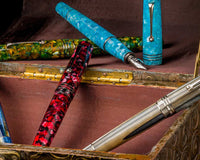The heart of a fountain pen lies in its nib. This metal tip makes writing possible and is the most distinctive part of a fountain pen. These components are crafted with precision and attention to detail to ensure they work well for years and even decades of use. However, just like any tool, they need occasional maintenance to perform at their best. Fountain pen enthusiasts are likely to encounter a damaged nib at some point in their writing endeavors. Fortunately, with a bit of patience and the right technique, repairing a fountain pen nib is possible. In this guide, we'll walk you through the steps to restore your fountain pen nib to excellent working condition.
Before Starting With Nib Repair
Before you start fiddling around with your fountain pen’s nib, there are a few precautions that you should take.
It is best to first become more familiar and comfortable with how a fountain pen works. Solving a nib issue will be easier when you have a basic understanding of the pen’s parts and how it functions as a whole.
When adjusting your fountain pen’s nib, it is best to go slowly and test your pen often. Even the smallest changes to your nib can lead to significant results.
The techniques we will be mentioning here are easy enough to perform. However, it is possible to permanently damage your pen and void the manufacturer’s warranty if these methods are carried out incorrectly. We advise you to proceed only if you accept the risks, otherwise, it is best to take your pen to an experienced nibmeister.
Issues That Require Nib Repair
Different types of issues may require nib repair. Here are some of the most common ones:
Dry Pen or Poor Ink Flow

When your pen has poor or inconsistent ink flow, it usually causes problems such as hard starts, skipping, or washed-out ink colors.
Check to make sure that your nib is sitting on the feed so that the nib slit aligns with the ink channel atop the feed. If these do not line up, then move the nib gently so that they do.
The top of the feed should also be right up against the underside of the nib. If there is a gap between these two components, then try rolling your nib. Using a flat surface, press your nib down against it and gently apply pressure to straighten it out. Slowly roll the nib horizontally from left to right.
Scratchy Pen
Sometimes a pen can become scratchy due to misaligned tines, which may happen due to heavy pressure when writing or accidentally dropping the pen. It can lead to a frustrating writing experience and damage both your pen and paper.
To remedy this, use a magnifying glass to check the alignment of the nibs and tines. Using gentle pressure, realign the tines with your fingernails until the scratchiness goes away. Remember to make minor adjustments at a time.
Ink Overflow

Many writers enjoy a wetter writing experience, but there is such a thing as too much ink flow in fountain pens. Unregulated ink flow can lead to too-wide lines, ink spills, and bleeding through paper.
To solve this problem, consider using a different ink that isn’t as lubricated, such as J. Herbin. If you have already done this and the problem lies in the nib tines being too spread out, then you can place the nib on its side and press down gently. Repeat on the other side.
The Bottom Line
Fountain pen maintenance is important for every writer. Regularly checking the condition of your fountain pens is essential to ensure that you prevent issues and permanent damage, especially when it comes to your nibs. Repairing your nibs can be done from the comfort of your own home, especially if you are dealing with more inexpensive pens. However, we do recommend that you consult a nibmeister if ever you are in doubt about how to fix your problematic nibs. This will ensure you get the best possible outcome for your favorite fountain pens.
As always, happy writing!
By Some Folks at EndlessPens







